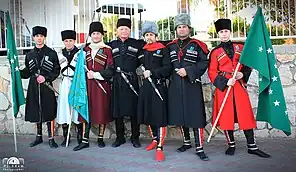 The variant used in the Circassian diaspora | |
| Unitary Flag Blessed Banner | |
| Use | National flag |
|---|---|
| Proportion | 1:2 |
| Adopted | In Circassia: First forms of it accepted in early 1800s, standard version in 1830 In Adygea: March 24, 1992 |
| Design | Twelve golden stars resembling a bow charged with three golden arrows on a dark green background |
| Designed by | Gerandiqo Berzeg |
The Circassian flag is the national flag of the Circassians. It consists of a green field charged with twelve gold stars, nine forming an arc resembling a bow and three horizontal, also charged with three crossed arrows in the center.[1] Seferbiy Zaneqo, a Circassian diplomat, is the designer of the flag.[2] Every year, April 25 is celebrated as the Circassian flag day by Circassians.[3][4][5]
Description
Symbolism and meaning
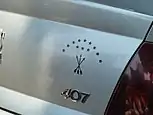
The green represents nature and Islam.[2] The golden colour represents a bright future in peace and the plentiful harvest of grain and wheat. There are twelve stars, representing the twelve provinces of Circassia.[6][1] There are three arrows, a reference to Adyghe Xabze in which they would mean "peace if you are my friend, war if you attack me".[2]
History and usage
Creation of the flag
An invasion of Circassia by Russia started in 1763,[7] and since then, the Circassians have been fighting the Russo-Circassian War in defense of their territory.[8][9] The Treaty of Adrianople was signed on 14 September 1829,[10] which stated that the Ottoman Empire recognized Circassia as Russian territory. Most Circassian leaders believed the treaty was a hoax, a strategy of the Russians, as they believed that the Ottoman Empire would never abandon the Circassians. It was decided to send a delegation to the Ottoman sultan to examine the accuracy of the news.[11]
Seferbiy Zaneqo was chosen as one of the delegates. Their mission was to meet with the Ottoman caliph to clarify the matter and receive a blessing. However, the Russian ambassador started pressuring the sultan to arrest them, and following this, the other delegates returned the Circassia while Zaneqo stayed.[11]
During this time, Zaneqo was injured during a demonstration against Russian Imperialism, and was hospitalised. When a Circassian man, Muhammad Selkhur, visited him, Zaneqo presented a folded paper, and clarified that it is a prototype for a Circassian unity flag, and that during his long hospitalization, he thought considerably about a symbol for the Circassian unity and he concluded on the contents of the paper. He explained that he took inspiration from previous Circassian symbols, and that each of the twelve stars represents a Circassian tribe and they are all equally represented without prejudice. As to the crossed arrows they represent that the Circassians do not seek war, but will defend themselves when attacked. A Circassian woman from the Ottoman harem knitted the flag and sent it to Circassia.[2][12]
David Urquhart self-proclaimed to be the designer of the flag, but there is no discovered evidence for his claims.[13] The Circassian flag was mentioned and described by the traveler Edmund Spencer in 1830, Urquhart arrived in Circassia much later.
Adoption and usage of the flag

The first copy of the flag was hand-delivered by the British delegate James Stanislaus Bell to Nour Muhammad Haghur in the Gesh Valley (in present-day Sochi). A council was held in the Psefabe Valley where representatives of the Circassian tribes met, in which the flag was presented and accepted.[2] The flag was then flown by Khirtsizhiqo Ale to cheers from Circassian commanders and a multitude of people.[14]
The Circassian people used this design ever since it was first adopted, including in the Russo-Circassian War. The flag is seen as one of the symbols of the Circassian nation by Circassians worldwide as well as one of the symbols of Circassian nationalism. This flag was also used by Circassians in the Circassian diaspora serving in several positions.
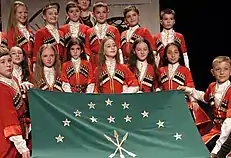
While the flag always survived among the Circassian diaspora, it lost its popularity in the Caucasus as a result of censorship during the Russian Empire and the Soviet Union, until it was repopularized by Ibrahim Nawurjan in 1989. Nawurjan, a history student at the Kabardino-Balkarian State University, discovered Edmund Spencer's book in the archives and resurrected the flag by painting it according to the description in the book. The flag was then adopted as a symbol of the Nalchik Circassian association. Nawurjan, a fervent Spartak Nalchik fan, helped popularize it among Spartak Nalchik supporters, and it later became popular among Circassians in the Caucasus again. On August 25, Nawurjan was killed on the Mamdzishha hill during the Abkhazian War, in which he voluntarily participated.[15] A historical surviving copy of the flag was later discovered, and compared to Nawurjan's design as well as designs in the diaspora, with all designs being identical in essence.
The Republic of Adygea adopted the present-day flag in a law of March 24, 1992. The proportions are 2:1.
Historical Circassian flags
Evolution of the current flag
| Flag | Years of use | Adopting Government | Notes |
|---|---|---|---|
 |
1600s–1810 | High Princedom of Kabardia | The coat of arms used by Kabardia. The white crescent represents Islam. The three stars represent eternity, dynasty and ideals. The arrows represent combat power and self-defense. |
 |
1700s?–1805 | High Princedom of Kabardia | First version of the green banner, used as the unitary flag of East Circassia. The design is imported from the coat of arms. |
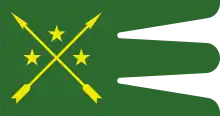 |
1805–1822 | High Princedom of Kabardia | The yellow and white part is removed. This version was also flown by prince Jankhot Qushuq. |
.svg.png.webp) |
Early 1800s– 1830 | Circassia | First known flag of a fully united Circassia proposal, flown by many Circassian commanders. There are eight stars, representing the eight regions supporting the proposal. The golden colour is replaced by black. Allegedly, there were alternative versions with Islamic symbols and swords. |
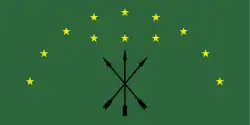 |
1830 – 21 May 1864 | Circassia (Circassian Majlis) |
Designed by Seferbiy Zaneqo, it was used as the flag of Circassia since the 1830s, and was officially adopted by the Circassian Majlis in 1860. The green represents nature and Islam. There are twelve stars, representing the twelve provinces of Circassia. The black is preserved for the arrows but the stars are golden. The arrows represent that the Circassians do not seek war, but will defend themselves when attacked. Removed after the fall of Circassia in 1864 following the Battle of Qbaada. |
 |
24 March 1992 – 7 June 2007 | State Council of the Republic of Adygea | First flag of the Republic of Adygea. The design was based on the flag of Circassia, but the colours and measurements were significantly different. The wartime flag is replaced with the peacetime flag; therefore black representing fight against Russian invasion was completely removed and replaced with a golden colour, while the stars were lifted higher. The golden colour was re-purposed to represent harvest of wheat. |
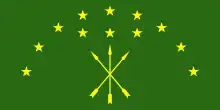 |
7 June 2007–Current | State Council of the Republic of Adygea | Current flag of the Republic of Adygea, adopted in 2007. The measurements are closer to the original Circassian flag. |
 |
1864–Current | None | The variant of the flag used in the Circassian diaspora, following the original measurements instead of the modern Adygea version. |
| Part of a series on the |
| Circassians Адыгэхэр |
|---|
 List of notable Circassians Circassian genocide |
| Circassian diaspora |
| Circassian tribes |
|
Surviving Destroyed or barely existing |
| Religion |
|
Religion in Circassia |
| Languages and dialects |
|
| History |
|
Show |
| Culture |
Other flags used by Circassians
| Flag | Years of use | Adopting Government | Notes |
|---|---|---|---|
 |
1382–22 January 1517 | Burji dynasty | Flag of the Circassian Mamluks in Egypt. |
 |
?-16th century | Zichia | As described in "Eastern Mediterranean and Black Sea. HM 35. JOÃO FREIRE, PORTOLAN ATLAS. Portugal (?), 1546" |
 |
1848–1859 | Circassia | "Circassian Islamic flag" described by Karl Marx. The flag itself is green and has a white sword with a crescent and a star on it. One of the flags during the reign of Muhammad Amin. |
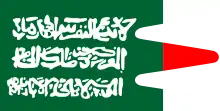 |
1848–1859 | Muhammad Amin's government | One of the flags of the Abdzakh region during the reign of Muhammad Amin. Exact replica of the flag of the Caucasian Imamate used by Imam Shamil. |
 |
1859 | Bzhedugh | Flag of the Bzhedugh region. |
| 1864 | Shapsug | Flag of the Shapsug region. | |
 |
1860 | Natukhaj | Flag of the Natukhaj region. It is a replica of the French flag with the text "Muhammad" added on it, representing the Islamic prophet Muhammad. There's also a variant with white text instead of yellow. |
 |
6 March 1917 – 30 November 1922 | Congress of the North Caucasian Peoples | Flag of the Mountainous Republic of the Northern Caucasus. The seven stars represent the Caucasian people and the stripes represent harmony. |
 |
1937 | Edmund Spencer | During the spread of the Circassian flag, it was drawn according to the available materials, so it appeared in different colors, but it kept its shape, like stars and arrows. |
Color scheme
Color scheme |
Green | Gold |
|---|---|---|
| RAL | 6002 | 1026 |
| CMYK | 61-0-82-39 | 0-0-99-1 |
| HEX | #296912 | #FDFC02 |
| RGB | 41-105-18 | 253-252-2 |
See also
References
- 1 2 Gammer, M. (2004). The Caspian Region: a Re-emerging Region. London: Routledge. p. 67.
- 1 2 3 4 5 Bashqawi, Adel (2017). "The Circassian Flag, the Homeland, the Circassian Identity". Circassia: Born to Be Free. ISBN 9781543447651. Retrieved June 10, 2019.
- ↑ efor (May 4, 2017). "Çerkezlerin Bayrak Günü ve Özgürlük Mücadelesi". insamer.com (in Turkish). Retrieved April 25, 2022.
- ↑ Узел, Кавказский. "День черкесского флага". Кавказский Узел. Retrieved April 25, 2022.
- ↑ "25 Nisan: Çerkes bayrağı günü". Ajans Kafkas (in Turkish). May 27, 2019. Retrieved April 25, 2022.
- ↑ (Abdzakh, Besleney, Bzhedug, Hatuqway, Qabardey, Mamkhegh, Natukhaj, Shapsug, Chemguy, Ubykh, Yegeruqwai and Zhaney)
- ↑ Natho, Kadir (2005). "The Russo-Circassian War". Archived from the original on May 12, 2022. Retrieved April 2, 2022.
- ↑ Richmond, Walter (April 9, 2013). The Circassian Genocide. Rutgers University Press. ISBN 978-0-8135-6069-4.
- ↑ King, Charles (2008). The Ghost of Freedom: A History of the Caucasus. New York City, NY: Oxford University Press. ISBN 978-0-19-517775-6.
- ↑ John Emerich Edward Dalberg Acton (1907). The Cambridge Modern History. Macmillan & Co. p. 202.
- 1 2 Bashqawi, Adel. Circassia: Born to Be Free. ISBN 1543447643.
- ↑ "ПУТЕШЕСТВИЯ В ЧЕРКЕСИЮ". www.vostlit.info. Retrieved November 16, 2019.
- ↑
Richmond, Walter (2013). "A Pawn in the Great Game". The Circassian Genocide. Genocide, Political Violence, Human Rights. New Brunswick, New Jersey: Rutgers University Press. p. 50. ISBN 9780813560694. Retrieved June 10, 2019.
[...] Urquhart claims to have met fifteen tribal leaders and nearly two hundred village chiefs, designed the Circassian flag, and helped them draft a petition to London for assistance.
- ↑ "ПУТЕШЕСТВИЯ В ЧЕРКЕСИЮ". www.vostlit.info. Retrieved November 16, 2019.
- ↑ "Науржанов Ибрагим – человек, воссоздавший черкесский флаг в Кабарде". Адыги .RU - Новости Адыгеи, история, культура и традиции адыгов (черкесов) (in Russian). Retrieved August 26, 2021.
